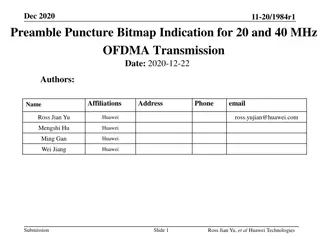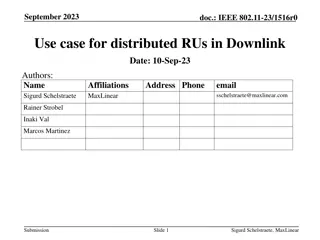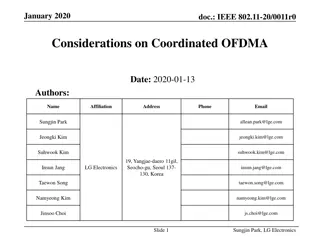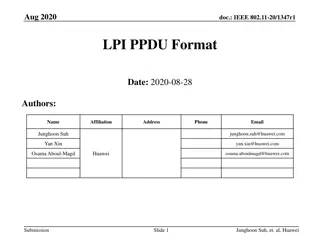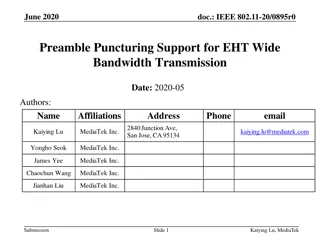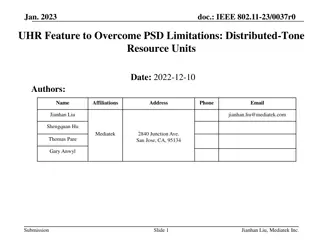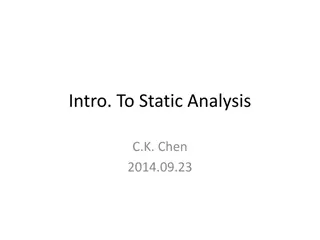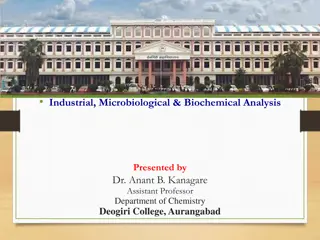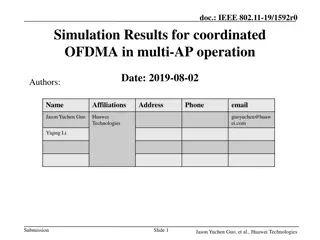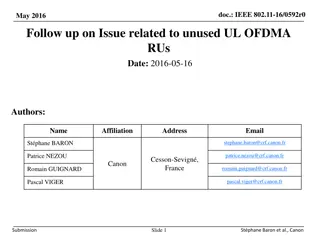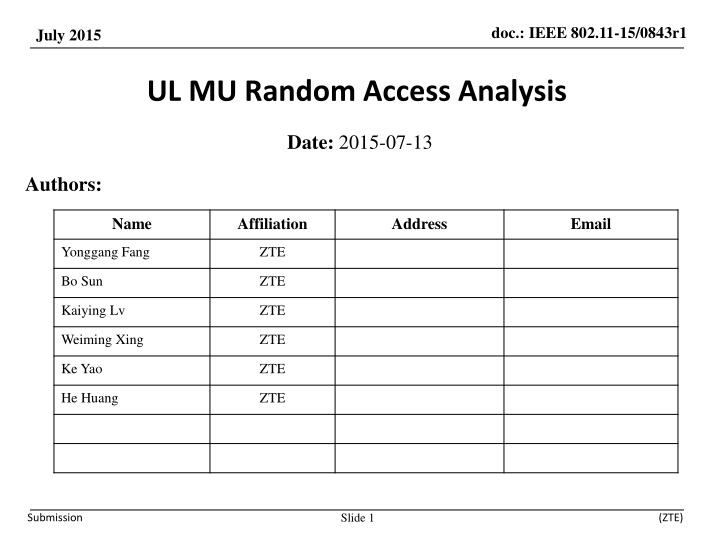
IEEE 802.11-15/0843r1 UL MU Random Access Analysis Summary
"Explore the analysis of UL MU random access performance in IEEE 802.11-15/0843r1 document regarding OFDMA, requirements, access procedures, and trigger frame indications. Understand UL MU transmission mechanisms and related issues."
Download Presentation

Please find below an Image/Link to download the presentation.
The content on the website is provided AS IS for your information and personal use only. It may not be sold, licensed, or shared on other websites without obtaining consent from the author. If you encounter any issues during the download, it is possible that the publisher has removed the file from their server.
You are allowed to download the files provided on this website for personal or commercial use, subject to the condition that they are used lawfully. All files are the property of their respective owners.
The content on the website is provided AS IS for your information and personal use only. It may not be sold, licensed, or shared on other websites without obtaining consent from the author.
E N D
Presentation Transcript
doc.: IEEE 802.11-15/0843r1 July 2015 UL MU Random Access Analysis Date: 2015-07-13 Authors: Name Affiliation Address Email Yonggang Fang ZTE Bo Sun ZTE Kaiying Lv ZTE Weiming Xing ZTE Ke Yao ZTE He Huang ZTE Slide 1 Submission (ZTE)
doc.: IEEE 802.11-15/0843r1 July 2015 Abstract 802.11ax SFD specifies OFDMA to be supported. UL MU transmissions can be scheduled by AP s trigger frame if AP has knowledge about STA s buffered data for UL transmissions, or triggered by AP to allow multiple STAs to perform UL MU random access to acquire TXOP for UL transmissions. In this contribution, we will analyze the OFDMA based UL MU random access performance and related issues. Submission Slide 2 (ZTE)
doc.: IEEE 802.11-15/0843r1 July 2015 Requirements in SFD PHY Legacy Preamble An HE PPDU shall include the legacy preamble (L-STF, L-LTF and L-SIG), duplicated on each 20 MHz, for backward compatibility with legacy devices. HE Preamble HE-SIG-A (using a DFT period of 3.2 s and subcarrier spacing of 312.5 kHz) is duplicated on each 20 MHz after the legacy preamble to indicate common control information Downlink HE MU PPDU shall include HE-SIG-B field, and the number of OFDM symbols of HE-SIG-B field is variable HE-STF of a non-trigger-based PPDU has a periodicity of 0.8 s with 5 periods. The HE-STF of a trigger-based PPDU has a periodicity of 1.6 s with 5 periods. A trigger-based PPDU is an UL PPDU sent in response to a trigger frame The HE-LTF shall adopt a structure of using P matrix in the data tones as in 11ac. Slide 3 Submission (ZTE)
doc.: IEEE 802.11-15/0843r1 July 2015 Requirements in SFD UL MU OFDMA An UL MU PPDU (MU-MIMO or OFDMA) is sent as an immediate response (IFS TBD) to a Trigger frame (format TBD) sent by the AP. HE-PPDU for UL-OFDMA shall support UL data transmission below 20 MHz for an HE STA. The amendment shall include a mechanism to multiplex BA/ACK responses to DL MU transmission. Submission Slide 4 (ZTE)
doc.: IEEE 802.11-15/0843r1 July 2015 UL MU Access Procedure Basic UL MU Access Procedure (example) HE UL MU random access HE UL MU transmissions HE UL Re-transmission HE UL MU RA HE UL MU Re-Transmission HE UL MU Transmission Response by STA1 PPDU from STA1 MU BA HE HE Trigger for UL MU RA MU BA PPDU from STA3 Resource Allocation. Response by STA2 PPDU from STA2 MU BA Response by STA3 PPDU from STA3 MU BA Response by STA4 PPDU from STA4 MU BA AP MU STAs AP AP MU STAs MU STAs AP Submission Slide 5 (ZTE)
doc.: IEEE 802.11-15/0843r1 July 2015 UL MU Random Access Requirements of Trigger Frame for RA Indication of UL MU procedure commence TXOP protection Protect other STAs including legacy STAs to content the medium in the TXOP Synchronizations Trigger MU STAs to perform frequency and timing synchronization with the AP so that the following UL MU transmissions from MU STAs could be aligned up at AP receiver. Polling Function Poll a list of STAs to allow them to transmit UL buffered data information Access Category Have higher priority over other frames to acquire the medium. Resource Allocation AP needs to schedule RBs for MU transmissions Power control level Allowed MCS rate Slide 6 Submission (ZTE)
doc.: IEEE 802.11-15/0843r1 July 2015 UL MU Random Access Analysis KPIs for OFDMA Random Access Trigger frame Overhead Random access latency Trigger based OFDMA response Success rate Overhead Padding Efficiency Slide 7 Submission (ZTE)
doc.: IEEE 802.11-15/0843r1 July 2015 Trigger Frame Overhead Trigger Frame Format Trigger frame is a special management/control frame to control RA TXOP or resource allocation for UL transmission. It has not decided yet how to define trigger frame, but some or more content should be considered in the trigger frame. For example: Common field: Min Access Category Length of STA Info STA Info AID or Temp AID Resource Block Min AC AID Length RB 2B 2B Common Info Field STA 1 Info STA n Info FC TA FCS Duration 2B 2B 6B 2B 2B 4B L-Preamble HE SIG MPDU Slide 8 Submission (ZTE)
doc.: IEEE 802.11-15/0843r1 July 2015 Trigger Frame Overhead Overhead in Single BSS Assumptions Preambles size 11ax preamble = L-Preamble + HE-Preamble (TBD) = 40us (same as 11ac) Transmission rates Use reliable MCS rate for legacy protection: 6Mbps Trigger Frame Overhead For polling 9 STAs for OFDMA based contentions 80us + 2* xSIFS = 112 us For polling 20 STAs for OFDMA based contention 109us + 2* xSIFS = 141 us Slide 9 Submission (ZTE)
doc.: IEEE 802.11-15/0843r1 July 2015 Trigger Frame Overhead Overhead in Multi-BSS Assumption Deployment case based on Scenario 3 of 802.11ax Simulation Scenario [5] 19 cells with cell radius R = 10m, reuse factor = 3. 10+ APs could be seen in OBSS [2] Trigger Transmission: is sent every 10ms Total Trigger Frame Overhead Trigger frame transmission by 10+AP will cause 1.4 ms overhead in 10ms period, which is about 14% air time used for trigger frames. If using RTS/CTS to protect trigger frame transmission, overhead would be even higher. Slide 10 Submission (ZTE)
doc.: IEEE 802.11-15/0843r1 July 2015 Trigger Based Random Access Latency OFDMA RA If a trigger frame is used to trigger the random access procedure, it needs to be transmitted as often as possible. Otherwise, it would cause more random access latency comparing to CSMA/CA. Assumptions Assume the trigger frame is transmitted every 10ms. 40 STAs per BSS, and 50% STAs have buffered data for UL transmissions Access delay If only 9 STAs are allowed to perform contention per trigger frame (for reduce collision probability), the probability that buffered STAs get a chance to contend is 22%, and half of them may transmit. If the STA depends on trigger frame (sent every 10 ms) to perform random access, the the average random access delay is > 5ms. Slide 11 Submission (ZTE)
doc.: IEEE 802.11-15/0843r1 July 2015 Trigger Based OFDMA RA Response Success Rate and Collision Probability If the allocated RB for RA and STA is not 1-to-1 mapping, there exists collision probability for two STAs to contend the same RB. To control collisions, AP may need to limit the number of STAs for RA. Assume that AP allows N of STAs to perform RA after trigger frame, which can randomly transmit trigger response in UL MU PPDU format, if they have buffered data. The maximum success transmission probability is 37% (slotted aloha model), which means at least 63% spectrum are wasted in OFDMA based random access. The more time the OFDMA RA trigger responses take, the less spectrum efficiency. Response by STA1 MU Spatial / Frequency Response by STA3 HE Trigger for Resource Allocation. HE Trigger for UL MU RA Domain Response by STA6 Response by STA7 AP MU STAs AP Submission (ZTE)
doc.: IEEE 802.11-15/0843r1 July 2015 Trigger Based OFDMA RA Response OFDMA PHY Overhead Assume HE PHY use following format Legacy and HE-SIG-A shall be same as they are transmitting over 20MHz. L-Preamble = 20us; HE-SIG-A = 2 x (3.2 + 0.8) = 8us HE-STF and HE-LTF may need to transmit over the allocated sub-channel. HE-STF = 1.6us x 5 = 9us HE-LTF = 6.4 (or 12.8)us + 0.8 (or1.6 or3.2)us <= 16us Total PHY header <= 53us HE- SIG-A L-STF L-LTF L-SIG HE-STF HE-LTF Data Slide 13 Submission (ZTE)
doc.: IEEE 802.11-15/0843r1 July 2015 Trigger Based OFDMA RA Response UL OFDMA MAC Overhead Assume HE payload is used to get bandwidth request. Therefore it could use same frame format. Total MAC size = 15B MAC Header = 10B Buffer Info = 1B FCS = 4B If using lowest MCS to transmit over one RB, the data rate would be 26/16us = 1.6Mbps. It takes 15 *8 / 1.6 = 75us The total OFDMA trigger response time (PHY + MAC): 75us + 53us = 128us If each STA would transmit individual payload with different size, it would take longer time and have deficiency issue of OFDMA padding FC TA FCS Duration Buffer Info 2B 2B 6B 1B 4B Slide 14 Submission (ZTE)
doc.: IEEE 802.11-15/0843r1 July 2015 Trigger Based OFDMA RA Response UL OFDMA Gain [4] analyzed MAC overhead on the impact of UL MU gain vs SU and provided the simulation results For 20MHz bandwidth, The gain of UL MU decreases as the data size increases since the overhead in UL SU transmissions would decreases. The control exchange overhead for UL MU should be less than a certain time in order to gain UL MU transmission. With the similar constrain of maximum control frame exchange, more STAs allowed for MU would provide higher gain. 4 STAs 8 STAs Gain of UL MU vs SU for 20 OFDM symbols payload 1.5x 1.5x 2.5x Max overhead for control frame exchange 178us 633us 184us Slide 15 Submission (ZTE)
doc.: IEEE 802.11-15/0843r1 July 2015 Trigger Based OFDMA RA Response Gain of UL MU vs SU If the trigger frame size takes 80+ us for example, it only leases 523us for the trigger responses based on the maximum time limit for control frame exchange (1.5x gain). Therefore it needs to design an efficiency way for UL MU random access procedure. UL MU Control Frame Exchange 8 STAs AP AP MU STAs Gain of UL MU vs SU for 20 OFDM symbols payload 1.5x 2.5x Response by STA1 MU Spatial / Frequency HE HE Trigger for UL MU Random Access Resource Allocation. Response by STA2 Domain Max overhead for control frame exchange 633us 184us Response by STA3 Response by STA4 Trigger + 2 * SIFS 110us 110us Max Trigger Response Time 523us 74us ??? 80+us SIFS SIFS Slide 16 Submission (ZTE)
doc.: IEEE 802.11-15/0843r1 July 2015 Trigger Based OFDMA RA Response OFDMA Padding Deficiency [3] provides analysis and simulation results for the OFDMA based transmission efficiency. Due to longer symbol duration, OFDMA would cause excessive padding in OFDMA transmissions. Especially when sending short packets in wide bandwidth, transmission efficiency drops significantly due to padding issue. 40 +44bytes1 576+44bytes2 1500+44bytes3 MCS0 (80MHz, NSTS = 1) 45.8% 8.67% 3.14% MCS1 (80MHz, NSTS = 1) 45.8% 18.6% 3.14% MCS2 (80MHz, NSTS = 1) 119% 18.6% 7.11% MCS3 (80MHz, NSTS = 1) 192% 18.6% 11.1% MCS4 (80MHz, NSTS = 1) 338% 18.6% 19.0% MCS5 (80MHz, NSTS = 1) 483% 58.1% 26.9% MCS6 (80MHz, NSTS = 1) 556% 77.8% 7.11% MCS7 (80MHz, NSTS = 1) 629% 97.6% 19.0% MCS8 (80MHz, NSTS = 1) 775% 18.6% 42.8% Slide 17 Submission (ZTE)
doc.: IEEE 802.11-15/0843r1 July 2015 Trigger Based OFDMA RA Response OFDMA Padding Deficiency If each STA is allowed to transmit any size payload in OFDMA random access TXOP, it has more severe issue of padding and would cause more waste. Since AP does not know STA s buffered data information, it cannot give accurate random access duration in the trigger frame. As a STA does not know size of PPDU of other STA s OFDMA transmissions, it has to pad the empty payload till the end of the random access duration. Response by STA1 MU Spatial / Frequency The better way to avoid padding issue is to keep same length of transmissions in UL MU OFDMA. Response by STA3 HE Trigger for Resource Allocation. HE Trigger for UL MU RA Domain Response by STA6 AP MU STAs AP Slide 18 Submission (ZTE)
doc.: IEEE 802.11-15/0843r1 July 2015 Summary Conclusion Trigger frame used to for random access might have some issues that impacts on user experience Longer random access latency Less transmission efficiency (time waste v.s. retransmission due to collision) Higher overhead. Trigger response efficiency decreasing due to Padding caused by UL MU OFDMA Overhead caused by extra frame exchange. We need some mechanism Reducing trigger frame overhead Improving trigger response efficiency Reduce the random access latency Slide 19 Submission (ZTE)
doc.: IEEE 802.11-15/0843r1 July 2015 References 1. 2. 3. 4. 5. 11-15-0132-05-00ax-spec-framework 11-15-0362-00-00ax-beacon-issues-2 11-15-0572-00-00ax-phy-inefficiency-of-256-fft-per-20mhz 11-15-0336-01-00ax-mac-overhead-analysis-of-mu-transmissions 11-14-0980-12-00ax-simulation-scenarios Slide 20 Submission (ZTE)


